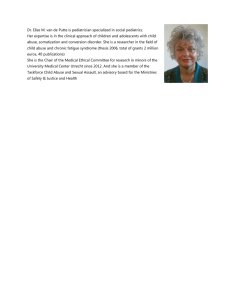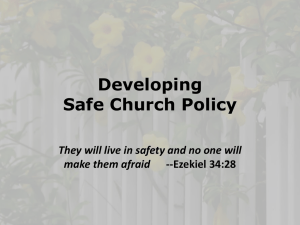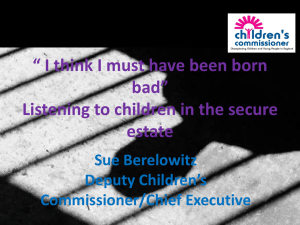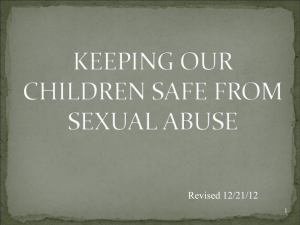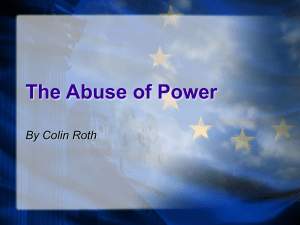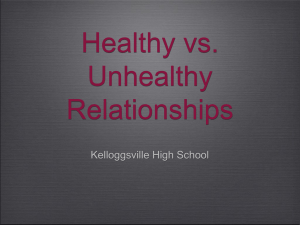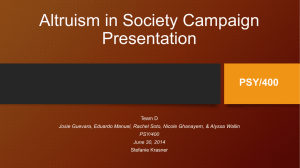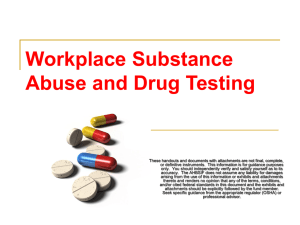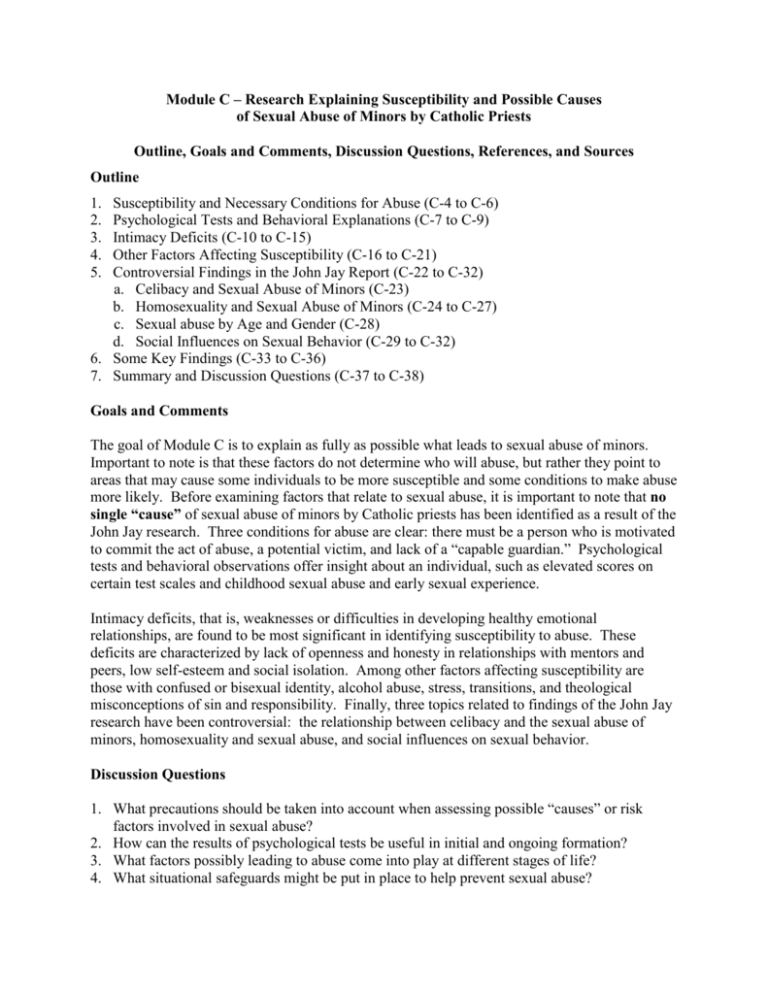
Module C – Research Explaining Susceptibility and Possible Causes
of Sexual Abuse of Minors by Catholic Priests
Outline, Goals and Comments, Discussion Questions, References, and Sources
Outline
1.
2.
3.
4.
5.
Susceptibility and Necessary Conditions for Abuse (C-4 to C-6)
Psychological Tests and Behavioral Explanations (C-7 to C-9)
Intimacy Deficits (C-10 to C-15)
Other Factors Affecting Susceptibility (C-16 to C-21)
Controversial Findings in the John Jay Report (C-22 to C-32)
a. Celibacy and Sexual Abuse of Minors (C-23)
b. Homosexuality and Sexual Abuse of Minors (C-24 to C-27)
c. Sexual abuse by Age and Gender (C-28)
d. Social Influences on Sexual Behavior (C-29 to C-32)
6. Some Key Findings (C-33 to C-36)
7. Summary and Discussion Questions (C-37 to C-38)
Goals and Comments
The goal of Module C is to explain as fully as possible what leads to sexual abuse of minors.
Important to note is that these factors do not determine who will abuse, but rather they point to
areas that may cause some individuals to be more susceptible and some conditions to make abuse
more likely. Before examining factors that relate to sexual abuse, it is important to note that no
single “cause” of sexual abuse of minors by Catholic priests has been identified as a result of the
John Jay research. Three conditions for abuse are clear: there must be a person who is motivated
to commit the act of abuse, a potential victim, and lack of a “capable guardian.” Psychological
tests and behavioral observations offer insight about an individual, such as elevated scores on
certain test scales and childhood sexual abuse and early sexual experience.
Intimacy deficits, that is, weaknesses or difficulties in developing healthy emotional
relationships, are found to be most significant in identifying susceptibility to abuse. These
deficits are characterized by lack of openness and honesty in relationships with mentors and
peers, low self-esteem and social isolation. Among other factors affecting susceptibility are
those with confused or bisexual identity, alcohol abuse, stress, transitions, and theological
misconceptions of sin and responsibility. Finally, three topics related to findings of the John Jay
research have been controversial: the relationship between celibacy and the sexual abuse of
minors, homosexuality and sexual abuse, and social influences on sexual behavior.
Discussion Questions
1. What precautions should be taken into account when assessing possible “causes” or risk
factors involved in sexual abuse?
2. How can the results of psychological tests be useful in initial and ongoing formation?
3. What factors possibly leading to abuse come into play at different stages of life?
4. What situational safeguards might be put in place to help prevent sexual abuse?
2
Titles of Slides and References
C-1:
Module C
C-2:
Title Slide
C-3:
Main Sources of Data
C-4:
Susceptibility and Possible “Causes” of Abuse
Note that no single cause or stable predictor is found among priest abusers or among the
general population of abusers.
C-5:
Susceptibility, 2: Three Necessary Conditions for Abuse to Occur
C-6:
Susceptibility, 3: Limits to Identifying Abusers
Notes: Causes and Context, p. 68
C-7:
Psychological Tests, 1
Notes: Causes and Context, pp. 51, 54, 59
Even though psychological test results are not definitive, elevations on the following
MMPI subscales are strongest:
-
Denial of Social Anxiety
Authority Problems
Persecutory Ideas
Amorality
Over controlled Hostility
Other possible risk markers for sexual abuse of minors include:
-
Elevations on Need for Affection
Social Imperturbability
Imperturbability
Inhibition of Aggression
These may also describe a sizable fraction of the adult population.
C-8:
Psychological Tests, 2
C-9:
Behavioral Explanations
C-10: Intimacy Deficits in Priests Accused of Sexual Abuse of Minors, 1
Notes: Causes and Context, pp. 49, 51, 69
3
Data sources:
– archival data on priests in 1970 from the Loyola Psychological Study of the American
Priest collected in 1971
– surveys of priests today, both those accused of abuse and those not accused – 500+
surveys and interviews
– clinical data from files of priests who received residential psychological treatment from
1985 to 2005; 1200 comprehensive surveys
The objective of the research was to discern individual or situational risk factors that
heightened the likelihood of engaging in sexual perpetration and whether there were also
identifiable protective factors that reduced this likelihood.
C-11: Intimacy Deficits and Psychosexual Maturity, 2
Notes: Causes and Context, p. 50
C-12: Intimacy Deficits: Immature Emotional Development, 3
Notes: Causes and Context, p. 68
For example, if an abuser’s emotional needs are not fully mature, he or she may relate
better to children than adults.
*Based on research by David Finkelhor; Child Sexual Abuse: New Theory and
Research, 1984.
C-13: Intimacy Deficits: Immature Emotional Development, 4
Notes: Causes and Context, p. 68
C-14: Intimacy Deficits: Immature Emotional Development, 5
Notes: Causes and Context, p. 68
C-15: Intimacy Deficits in Early Childhood and Sexual Abuse, 6
C-16: Other Factors that Affect Susceptibility to Commit Acts of Sexual Abuse
Notes: Causes and Context, 2nd bullet only, p. 69
C-17: Other Factors, 2: Stress and Abuse
C-18: Theological Misunderstanding and Sexual Abuse
C-19: Cognitive Dissonance, 1
Notes: Causes and Context, p. 68
4
Dissonance is often strong when individuals believe something about themselves and
then act in a manner contradictory to that belief. If an abuser believes he is good but then
commits an act that is bad, the resulting feeling of discomfort is an example of cognitive
dissonance.
C-20: Cognitive Dissonance, 2
Notes: Causes and Context, pp. 68-69
The adaptations are not mutually exclusive. Since sexual abuse of children is considered
wrong, some offenders may cease the activity following an initial encounter
Others may rationalize the behavior and focus on the “positive” aspects of the
relationships, such as offering the child love and affection or teaching the child about sex.
Still others may introduce new information, for example, assisting the child with
homework to help minimize the dissonance felt as a result of their actions.
C-21: Progression of Risk Factors Related to Abuse
C-22: Some Controversial Findings in the John Jay Report
C-23: Celibacy and Sexual Abuse of Minors
Notes: Causes and Context, p. 35
(See also A. Greeley, “Celibacy Isn’t a Cause of Sex Abuse,” Chicago Sun Times,
February 13, 2008.)
C-24: Homosexuality and Sexual Abuse of Minors, 1
Notes: Technical slide T-26
C-25: Homosexuality and Sexual Abuse, 2
C-26: Homosexuality and Sexual Abuse, 3
C-27: Other Views Concerning Homosexuality
C-28: Sexual Abuse by Age and Gender
C-29: Social Influences on Sexual Behavior, 1
C-30: Other Social Influences, 2
C-31: Social Indicators of Deviance: Rates of Change from 1960 to 1990
Notes: Causes and Context, p. 126; see also John Jay Technical slide T-12:
5
C-32: Conclusion to be Drawn
C-33: Some Key Findings – 1
C-34: Some Key Findings – 2
C-35: Some Key Findings – 3
C-36: Some Key Findings – 4
C-37: Summary of Susceptibility and Possible Causes of Sexual Abuse
C-38: Discussion Questions
Sources
This module and others prepared for use in seminaries and schools of theology are based
primarily on the two reports presented to the United States Conference of Catholic Bishops by
the John Jay College Research Team, The City University of New York: The Causes and
Context of Sexual Abuse of Minors by Catholic Priests in the United States, 1950-2010, March,
2011 and The Nature and Scope of Sexual Abuse of Minors by Catholic Priests and Deacons in
the United States, 1950-2002, February 2004.
Prepared by:
Sister Katarina Schuth, O.S.F., St. Paul Seminary School of Divinity, University of St. Thomas
Technical Associate: Catherine Slight
Consultants: Dr. Karen Terry and Margaret Smith, John Jay College of Criminal Justice, authors
of the major studies on sexual abuse for the USCCB and Dr. Mary Gautier, Center for Applied
Research in the Apostolate
Reviewed by numerous seminary personnel

